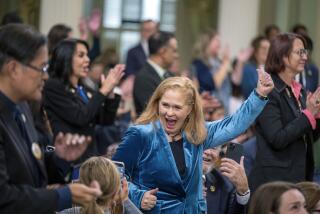Brown Heads Vote to Keep Assembly TV Effort Going
- Share via
SACRAMENTO — Brushing aside Republican concerns over excessive costs and the potential for partisan abuse, Democrats on Tuesday voted to spend $1.1 million to televise proceedings of the California Assembly.
Assembly Speaker Willie Brown (D-San Francisco), the driving force behind a fast-track effort to broadcast the sessions to the homes of Californians, cast the tie-breaking vote on the Rules Committee to proceed with the venture. The action does not require approval of the full Assembly.
Brown, keying on the results of a three-month experiment last summer, said the Assembly must move quickly toward building a permanent television facility “to assure that we will be on-line by the time of (the governor’s) State of the State Address” Jan. 10.
However, Republican members of the committee questioned whether the “bare-bones” but “state-of-the-art” cameras and other equipment authorized by the vote would be restricted to unedited broadcasts from the Assembly or might also have the capacity to produce partisan propaganda.
“Are we setting up post-production videos to send out to make the Assembly look great, or are we doing live, gavel-to-gavel (coverage)?” asked one suspicious Republican, Assemblyman Richard Mountjoy of Monrovia.
Assemblywoman Lucille Roybal-Allard (D-Los Angeles), who served on a bipartisan task force that investigated proposals for televising Assembly sessions, and others sought to reassure Mountjoy that the $1.1 million in equipment approved for purchase was intended only for nonpartisan broadcasts.
Over GOP opposition, Democrats on the Rules Committee prevailed on a 5-4 vote to authorize the purchase. Brown is not a member of the committee but was hastily seated to substitute for an absent Democrat and cast the tie-breaking vote.
No television station outside Sacramento staffs and operates its own Capitol bureau, although one broadcast news operation contracts to provide service to client stations. Among other leaders, Brown has argued that Californians would be better informed if the Assembly created its own television service.
The Senate, meantime, is moving more slowly toward televising itself. One consideration is finding money at the same time staff reductions are being considered to comply with voter-approved Proposition 140, which limited legislative terms and spending.
Still to be resolved is how the television signal from the Assembly will be distributed throughout California. Brown and the Democrats said they are looking toward a nonprofit organization known as Cal-Span to transmit the signal by satellite to cable operators.
Paul Koplin, executive director of Cal-Span, indicated that his group must receive start-up financial donations from corporations and foundations before it can distribute the signal. He said this may be months away and stressed that Cal-Span wants assurance that the signal from the Assembly will be free of Assembly editorial changes before it is relayed to cable and other viewers.
Brown on Tuesday described the proposed permanent television facility in the Assembly and the purchase of equipment as an “appropriate” conclusion to the three-month test last summer in which the lower chamber experimented with broadcasts statewide to cable and other television viewers.
The project received rare bipartisan praise and the concept of providing permanent, unfettered television coverage was embraced by Democrats and Republicans alike. Equipment vendors have been asked to submit bids on a production facility that would range from $1.1 million to $2.5 million.
In the past few days, however, former GOP Leader Pat Nolan of Glendale and other Republicans have voiced concern that proposals for a permanent facility go “far beyond” the concept of simple gavel-to-gavel coverage such as that provided of Congress by the nationwide C-SPAN system.
These Republicans contended that some of the equipment is too expensive in the current era of governmental austerity. They also raised concerns that the system would have the capacity to be used for partisan purposes, such as elaborate videos designed to make the majority Democrats look good.
Democrats and their staff assistants countered that rules will be adopted to assure nonpartisan use of the television facility. They argued that highest-quality equipment must be obtained to assure quality production.
Assembly GOP Leader Ross Johnson of La Habra, who attended the Rules Committee hearing, told reporters later that the GOP supports televising Assembly proceedings. But he said he, too, shares “the legitimate” concerns about cost and potential partisan abuse.
More to Read
Get the L.A. Times Politics newsletter
Deeply reported insights into legislation, politics and policy from Sacramento, Washington and beyond. In your inbox twice per week.
You may occasionally receive promotional content from the Los Angeles Times.










